Click to Call
401-954-1053


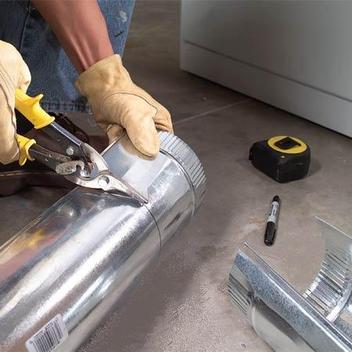
Does your dyer vent need repair? The good news you will find here is that there are not a lot of problems associated with a dryer vent system. It is a pretty reliabe system when installed properly. However improper installations of dryer ducts do take place.
Some of the common problems associated with dryer vent systems are improper support of the ducting which can result in sagging ducts that cause misalignment and leakage in the dryer vent system. Other problems involved with improper installation have to do with the materials used and the inherent problems associated with using those materials. I've listed some of the more common problems associated with the dyer vent system that we can repair for you to get your system working better than new. See below
Dryer duct venting -dryer ducts
need to vent to the exterior of the home and not into the attic,
crawlspace, sunroom or other interior space where continuous moisture
can allow mold to breed.
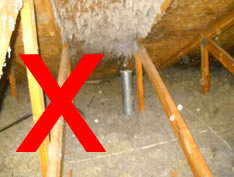 A disconnected clothes dryer duct can exhaust a large amount of lint and
moisture into the home. This creates problens like mold which can
become a serious health hazard and lint which can build up and
accumulate to become a source of spontaneous ignition for the smallest
spark of fire.
A disconnected clothes dryer duct can exhaust a large amount of lint and
moisture into the home. This creates problens like mold which can
become a serious health hazard and lint which can build up and
accumulate to become a source of spontaneous ignition for the smallest
spark of fire.
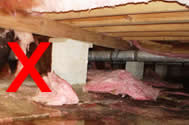 Therefore you should check on a dryer duct that passes through any
obscured area or rarely visited space, such as an attic or crawl
space, periodically to make sure that everything is still properly
connected. Since, it is very important to avoid moisture buildup of any
kind within a home, all dryer vents must exhaust to the exterior of
the home If you need to have your dryer vent rerouted to the exterior of
your home we can help you just give us a call at 401-954-1053
Therefore you should check on a dryer duct that passes through any
obscured area or rarely visited space, such as an attic or crawl
space, periodically to make sure that everything is still properly
connected. Since, it is very important to avoid moisture buildup of any
kind within a home, all dryer vents must exhaust to the exterior of
the home If you need to have your dryer vent rerouted to the exterior of
your home we can help you just give us a call at 401-954-1053
Dryer Duct construction- The dryer duct work should be constructed from rigid metal, and be at least 4" in 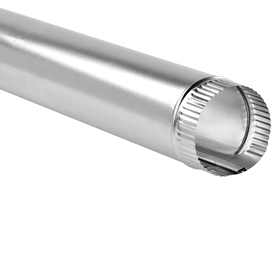 diameter and most importantly because it is a dryer vent duct with lint
constantly flowing through the venting system, it must have a "smooth
interior" so that the lint doesn't have a place to build up and
accumulate causing a blockage. The entire duct needs to be
supported by hangers and secured properly, and no screws are allowed
to penetrate the joints because they could accumulate lint. Using
the wrong material for your dyer duct can result in moisture buildup in
the venting ducts so that the lint sticks to the sides of the vent. This
is a common problem when builders use PVC as the material of choice for
their dryer vent duct work. Although this kind of dryer blockacge can
usually be prevented with regular maintenance.
diameter and most importantly because it is a dryer vent duct with lint
constantly flowing through the venting system, it must have a "smooth
interior" so that the lint doesn't have a place to build up and
accumulate causing a blockage. The entire duct needs to be
supported by hangers and secured properly, and no screws are allowed
to penetrate the joints because they could accumulate lint. Using
the wrong material for your dyer duct can result in moisture buildup in
the venting ducts so that the lint sticks to the sides of the vent. This
is a common problem when builders use PVC as the material of choice for
their dryer vent duct work. Although this kind of dryer blockacge can
usually be prevented with regular maintenance.
Transition Ducts are the most obvious,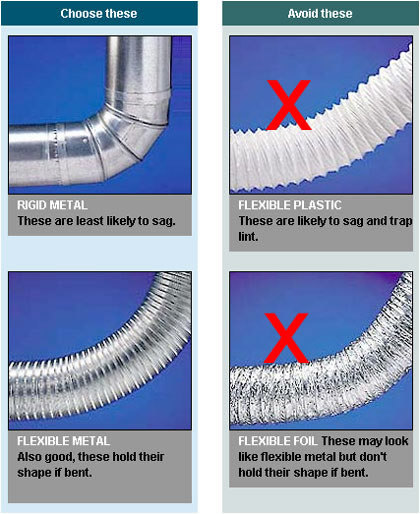 and possibly most common means of dryer vent fires. The reason for this
is because of the materials used in the transition between the dryer
and the vent system. Many homeowners use transition venting that is not
allowed by code such as plastic dryer ducts or aluminum foil ducting
and which is easily compromised should a fire occur. Plastic and
aluminium foil venting is not allowed for dryerducts because
lint can also easily accumulates in the corrugated ridges or when the
duct when it sags, making it an easy conduit to bring the fire into the
interior walls of your home.
and possibly most common means of dryer vent fires. The reason for this
is because of the materials used in the transition between the dryer
and the vent system. Many homeowners use transition venting that is not
allowed by code such as plastic dryer ducts or aluminum foil ducting
and which is easily compromised should a fire occur. Plastic and
aluminium foil venting is not allowed for dryerducts because
lint can also easily accumulates in the corrugated ridges or when the
duct when it sags, making it an easy conduit to bring the fire into the
interior walls of your home.
Therefore all plastic or aluminum foil ducts should be considered a potential fire hazard, and should be not be used as transition ducts, but should be replaced with rigid metal. If flexible material must be used, a maximum of eight feet is allowed, and flexible "metal", not foil, should be used.
BackDraft Damper- Watch for birds making nests in dryer vents especially in early spring. This can significantly 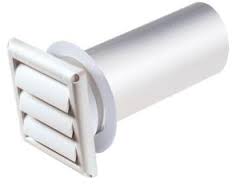 reduce the efficiency of the dryer unit. This often happens when the backdraft
damper is missing at the termination point of the dryer vent duct
outside the house. The terminal for the dryer needs to have a backdraft
damper, and no screens are allowed at the dryer exhaust. When
screens are installed, they get clogged with lint. This reduces
the performance of the dryer and creates a potential fire hazard.
reduce the efficiency of the dryer unit. This often happens when the backdraft
damper is missing at the termination point of the dryer vent duct
outside the house. The terminal for the dryer needs to have a backdraft
damper, and no screens are allowed at the dryer exhaust. When
screens are installed, they get clogged with lint. This reduces
the performance of the dryer and creates a potential fire hazard. 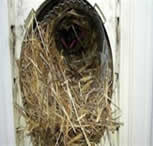 Some
people have expressed concern that pestsmight get in to the clothes
dryer duct if a screen isn't installed, but if the backdraft damper at
the exterior is kept clean, this should never be an issue.
Some
people have expressed concern that pestsmight get in to the clothes
dryer duct if a screen isn't installed, but if the backdraft damper at
the exterior is kept clean, this should never be an issue.
Dryer duct length -Generally speaking the maximum allowable length for a clothes dryer duct is about 25 feet. For each 90 degree turn in the duct reduces the length of the duct by approximately 5 feet, and for each 45 degree turn the duct is reduced about 2.5 feet.
For a normal basement in Rhode Island, the clothes dryer has a 90 degree turn in the duct right behind the dryer, then another 90 degree turn at the ceiling. Assuming it's a 7' ceiling, this leaves 8' of run before the dryer duct needs to terminate at the exterior, according to these requirements.
While many clothes dryers have a longer run than this, it's not always a problem. There's an exception to the rule which says "where the make and model of the clothes dryer to be installed is known and the manufacturer's installation instructions for such dryer are provided to the code official, the maximum length of the exhaust duct, including any transition duct, shall be permitted to be in accordance with the dryer manufacturer's installation instructions.". In other words, if the dryer manufacturer allows a longer duct, no problem.
Clothes dryer maintenance is actually quite simple: keep it clean. Dryer lint is flammable, and the more that accumulates in the dryer and the duct, the greater the risk. The most obvious and routine part of this is keeping the lint screen clean - it should be cleaned after every load.
Periodically check the damper at the exterior to make sure it's clean; when lint accumulates at the damper it will eventually cause the damper to stay open.If you're unfortunate enough to have a dryer that exhausts through the roof... I'm sorry to hear it. Someone needs to get up there on a regular basis to clean the damper.
Take a peek behind your dryer with a flashlight periodically - it's quite common for the dryer to come disconnected from the duct, which makes a big mess of flammable lint behind the dryer. The dryer duct itself needs to be cleaned periodically as well.
Dryers are the number 1 source of fire in the home!
Most people don't realize that dryer lint is extremely flammable and can lead to a dryer fire that can rapidly spread throughout your home. The U.S. Consumer Product Safety Commission (USCPC) commissioned a report back in 1999 which was entitled the “Report on Electric and Gas Clothes Dryers.” In the report it was determined that of the 15,000 fires studied in one year, electric dryers were over 2.5 times more likely to be the cause of the fire than gas dryers.
